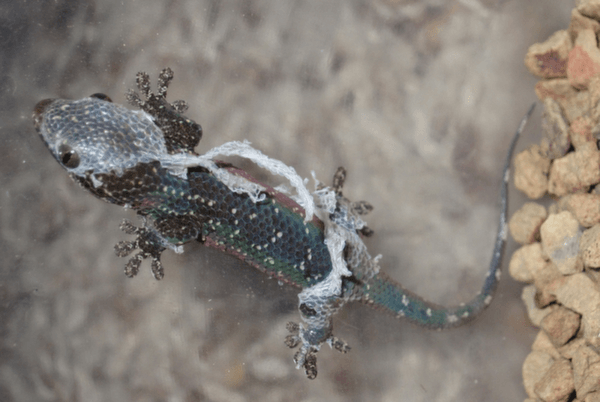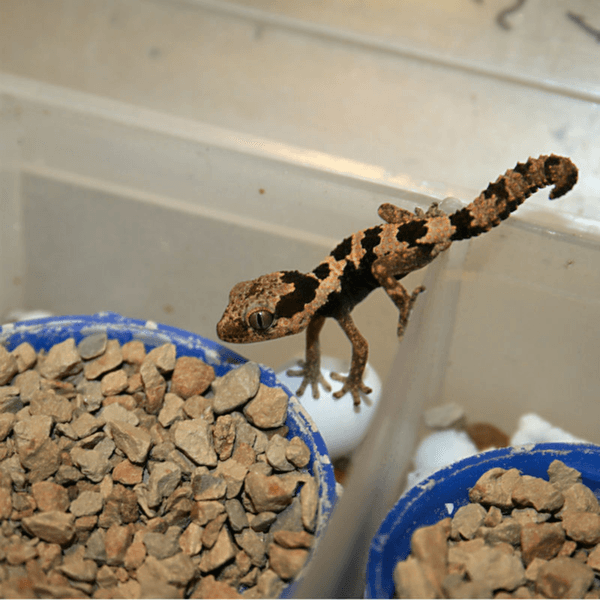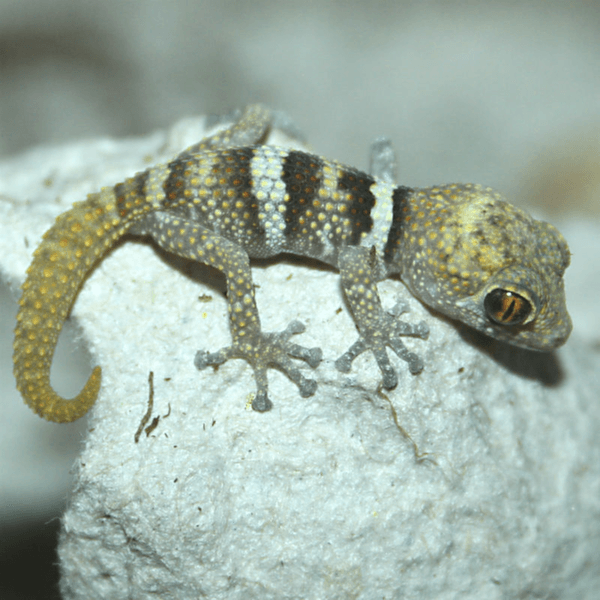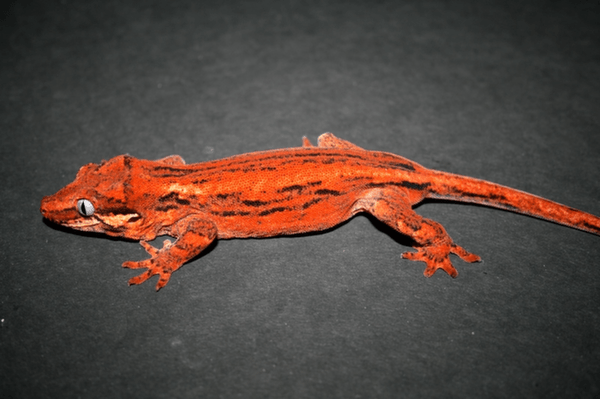A year ago, Gecko Time asked a number of our contributors to reflect on the previous year of gecko keeping and let us know their plans for 2014. This week, we present a followup from 10 of the original contributors who comment on how 2014 actually played out, compared to what their plans were. Note that this article is especially valuable to readers who are contemplating purchasing some of the species or morphs of geckos that the breeders are working on in the coming year.
Garrick DeMeyer of CrestedGecko.com
Last year he wrote:
[In 2014] I’m planning on keeping my collection about the same size. I made a conscious effort to reduce my collection a couple of years ago, so I could focus on producing smaller numbers of very high quality geckos — enough to keep my website full, but not so many that I get overwhelmed with babies. I am focusing on producing morphs with bright color and bold pattern- trying to improve upon the looks of the morphs I produce, not necessarily trying to produce brand new morphs. I don’t really have anything I’m looking to add to my gecko colony in 2014. If I see any outstanding individuals that I think would complement my collection, I will add them.
I am mostly just trying to produce the nicest examples of my existing morphs that I can. I’m doing a lot of cool reverse stripe leopard geckos including bold black, lavender, and tangerine. I’ve also produced a new line-bred morph I call “skittles” because of the assortment of subtle colors throughout the body. Some of the geckos that have come out of my Skittles line have tri-stripes. A reverse stripe down the back and two smaller reverse stripes starting at the neck and shoulders and running down the back. They are really cool, unusual geckos!
2014 went pretty much as planned. I produced fewer geckos than in previous years, which is exactly what I wanted. My goal was to produce outstanding individuals of a few select morphs. I ended up holding a lot of the best ones back to further enhance my breeding colony. I sold a few of my nicer geckos to other breeders. Some sold through my website and many sold at shows.
I don’t think there was anything specifically that contributed to the year I had with geckos, other than pairing the geckos up that I thought would give me the best results. It is mostly just about keeping up with the breeding process- feeding, watering, collecting eggs, incubation, etc. I’ve been breeding them for over 20 years now, so it is pretty second nature to me.
2015 should be another good year. I have a few new groups of geckos set up and ready to start laying soon. These are babies that I hatched in ’14 and raised up. The best of the best!
Dan Martindale of Chaotic Nights Reptile
I will be expanding a little in 2014 and breeding some new gecko species.
I would love to acquire some Rhotropus boultonI will be expanding my flying gecko and red eyed crocodile skink projects. Also attempting to acquire more gekko smithii and begin breeding these as well.
My 2014 was a slow year, I moved in 2013 and the disruption seemed to of thrown all my geckos for a loop. Very few animals bred or produced any offspring; even my L. lugbris produced just a handful of eggs.
I think the environmental change going from AZ to WI was a big factor [in what happened in 2014]. I needed to re-calibrate all the animals’ heat and humidity. The two states had drastically different issues to tackle. Also nobody warned me that everything even slightly damp would mold instantly in WI.
I did acquire a pair of B. saklava and do hope for babies sometimes in 2015.
Kevin Saunders of Appalachian Ectotherms
2014 should see some expansion in my reptile room, both in numbers and diversity of species.
I’ll potentially be looking for more Oedura, Paroedura, Afroedura (notice a theme?) and I may end up trying a few new Hemidactylus species.
I just started incubating my first Uroplatus egg, so I hope to hatch a few nice henkeli next year. I just pulled the trigger on my first Nephrurus, but will probably have to wait until 2014 to receive them due to shipping weather and the holidays. I don’t anticipate many new purchases or projects next year, but I hope to get my first eggs from a few species I’ve been growing up and I may add to a few breeding colonies.
I’ve always had trouble sticking to my own plans when it comes to reptile projects.
This year I ended up getting quite a few Chondrodactylus, a few different parthenogenic geckos, some interesting Hemidactylus, and several gargoyle geckos. I also started keeping a large Geckolepis species (something in the maculata complex) that I really enjoy and I managed to hatch a few from the wild caught parents already. I also parted with some geckos that I plan to revisit in the future (Coleonyx, Paroedura, and Pachydactylus species).
So in some respects I followed through with what was planned, but I also had some unexpected developments as well.
Some geckos didn’t produce for me as I’d hoped and I ended up with very unfavorable sex ratios of a few species, so I did quite a bit of selling and trading to balance things out. That was probably the single biggest wrench in my plans over the last year. I’m planning to downsize overall in 2015 since I’ve got a few other lizard projects crowding my reptile room. At the moment, my gecko plans for the next year include Oedura castelnaui, different clone lines of mourning geckos, Hemidactylus triedrus, a few different Chondrodactylus, and Geckolepis. If space permits, I may also pick up some Homopholis and Coleonyx.

Kristi Housman of Ghoulish Geckos
I am cutting down on gecko projects, but hopefully branching out into some non-gecko breedings.
My main thing on my wish list is just to have the season go as planned. As for animals, the list is huge! I’m always finding things that I want if I had the space.
My leopard gecko projects will mostly be eclipse het tremper/possible het tremper (including w/y), eclipse het bell/radar, and blood hypo tangs. One new project for me is breeding my pair of yellow ackie monitors. I’m also hoping to get a couple other new projects going, but I’m still trying to decide what I want the most.
I had planned on cutting back on my leopard gecko projects in 2014 which I did. However, my production was even lower than I expected. Most of my babies hatched late in the season which now prevents me from being able to ship for awhile since the weather is so cold. I did however produce my first yellow ackies. I added quite a few more animals with the hopes of getting more projects going.
I think I oversold and cut back too much. I also had a few breeders who gave me infertile eggs and didn’t produce at all.
I’m hoping to bounce back and produce more for the 2015 season. I spent a lot of time last year buying leopard geckos with the hopes of breeding more again. I want to be careful to not overproduce, but I would like to do better than 2014. I added a Coleonyx mitratus pair that I’m hoping to breed. Most of my other animals will not be big enough to produce next year, so they will continue growing and hopefully will be ready in 2016 or 2017. Who knows what I’ll add this year, too. Maybe some more Coleonyx. Maybe a few things. I’m looking forward to seeing what happens.
Maureen Winter
In 2014 my plans are to continue reducing my Collection down to only a few Day Geckos and focus more on other types. Lately I have a real fondness for Paroedura and other night active Genera.
I am going to try and be good this year, so I am not planning to buy anything new until I am able to reduce my Collection first.
In 2014 I will begin breeding Paroedura vazimba & Hemidactylus imbricatus.
I would say this year I spent more time reducing offspring, than my actual collection of permanent animals as planned. Also as the year went on, I went a little off plan and ended up adding in some more permanent animals. Oops!
While I did spend a bit of time working with the P. vazimba and H. imbricatus as planned. I ended up more working with Sphaerodactylus instead. I also had an accidental add-in of another Gonatodes species and am now finding myself wanting to add in even more of this genus.
I spent a lot of this year with health issues, so really I only mainly focused on reducing offspring instead.
In 2015, i hope to get back to my original goal of reducing and if this means only offspring for now, so be it. There are always more years ahead. 😉
Wally Kern of Supreme Gecko
We plan to stay the same and expand! Our breeding stock will not change much at all as I am working with the species I love. However, I am hoping to breed several 2013 new acquisitions in ’14 and that will be exciting.
It sounds odd but we picked up some ‘wish list’ animals in 2013 and will be focused on breeding them this up coming year. If I had to pick one ‘wish list’ animal, it would be Phelsuma klemmeri (again).
[Describing my plans for 2014] is difficult as it is so diversified- from new Hemidactylus, Sphaerodactylus, and Paroedura to better examples of crested colors and patterns (dalmatians, red harleys, red pinners, and others). I hope to start offering some more difficult species to the hobby in 2014.
This past year I added three cave gecko species, two African geckos, one banded. No new leos or crested. I bred about 12 different species in 2014.
From the new geckos I acquired in 2013, I bred Pachydactylus rogusus, P. bastardi, and a few Sphaerodactylus.
In terms of my plans to offer more ‘rarer’ geckos for sale, I started offering some Africans and Paroedura stumpffi. I need to stop holding everything back and offer some more for sale.
I’m working on some new color lines in cresties (better quality).
My interests change quicker than the direction of the wind! ‘Focus’ this year was the key and I concentrated on each species to better provide for their needs. My plan is to continue this focus into 2015.
My goals include:
Webpage changes: adding to the Supreme Gecko web page: New Collection pages, Species pages, Daily (or weekly) blog, and more regular features
Giveaways: With the success of The 12 Supreme Days of Christmas, we will be doing regular giveaways.
Facility: Developing a new Micro gecko setup
Animals: Focus on breeding what I have (add 5 or less new species)



Aliza Arzt of Geckcessories
My breeding population will remain more or less the same, with the hopes of increasing the number of females that actually produce.
I’m pretty much at capacity for geckos, but do hope to obtain a W&Y leopard gecko to be a breeder in 2015.
I have 8 L. williamsi eggs incubating and hope to have more success with the hatchlings. I’m also hoping that I’ll be successful with my newest AFT project and will be able to produce white-outs and patternless white-outs.
I generally had a successful breeding season and produced offspring from 6 of my 8 leopard gecko females. Unfortunately, I had a higher percentage of minor defects in offspring than I have had in the past, including some characteristics I’ve never seen before: tip of the tail kinks, and loose rear leg ligaments. The leos have not been selling as quickly this year as other years, and I have plans to cut back to 4-5 female breeders from 8 for next year.
I had a very poor L. williamsi season, hatching seven, all of which died within the first 10 days. I am planning to try again, though. Changes for the coming season include holding off on breeding until spring, when the ambient humidity will be higher, and providing a planted hatchling enclosure which is currently growing out nicely.
My patternless whiteout AFT breeding group produced a few hatchlings this season, but no whiteouts. Several of them didn’t survive. I am proudest of the single tangerine patternless gecko I produced and am hoping for better luck next season.
I didn’t end up getting a W&Y leopard gecko, and am considering severely reducing or phasing out leopard gecko breeding (by not adding new breeders). I still have Coleonyx elegans on my wish list and hope to add a pair next season.
Tony Terradas of ROC Geckos
2013 was a great season at Roc Geckos. Some of my long-awaited projects finally matured (chahoua, white collar sarasinorum, agricolae) and gave me a strong first season. I also added a few new projects that I’m looking forward to starting in 2014 including uroplatus henkeli, paroedura stumpffi, phelsuma klemmeri, phelsuma q. quadriocellata and phelsuma standingi. In addition to starting those projects in 2014, I’m planning on selectively adding a few projects including a strophurus species and another pair of Coleonyx elegans.
2014 ended up being a strong year for those matured projects I was looking forward to at Roc Geckos (chahoua, sarasinorum, agricolae, klemmeri, quadriocellata), but it was an even better year for expanding breeding projects for 2015/16. I added all of the breeding projects I planned on as well as adding some dream projects to the roster due to a strong year and simply being in the right place at the right time. I was able to add pairs of nebulifera/oedura: robusta, castelnaui, marmorata, monilis as well as 2 pair of uroplatus phantasticus. 2015 will be the first year I don’t look to actively expand my projects and simply focus on strong production from 17 different species.
Ben Bargen of Art Geckos
Art Geckos produced 94 geckos in 2013, and we expect to triple our production for the 2014 season. We are eager to utilize genome sequencing to better understand various mutations, and contribute to the scientific understanding of these fantastic animals. While we are looking forward to producing novel combination morphs, such as HC^2 White & Yellow’s, we are just as enthused to refine distinct lines of Enigmas with little to no ES. We will continue our commitment to providing public access to new information on leopard gecko health & genetics.
In addition to revealing a plethora of new-to-us combination morphs, such as Blackholes, Novas & Dalmatians, in 2014 we produced a handful of strikingly unique animals. These novel morphs include vibrant WY High-Contrast Raptors, ES (Enigma Syndrome) Free BEEs with 1/2 black 1/2 Orange eye pigmentation, and Leo’s with 50% yellow tails.
While we carefully select each male and female to optimize beauty and diversity, the success of our 2014 season can be attributed to favorable probabilities, genetically diverse foundation stock, and AMP Energy Drinks.
We are excited to produce Diablo Blancos & Cyclones in 2015, and we will also be releasing Posters of original artwork. We continue to pursue the idea of sequencing the leopard gecko genome, and have fortified our commitment to deliver top-notch resources on the health & genetics of these fantastic animals.
Oli Kuepper of Raw Dog Reptiles
With the expansion of space, including separate rooms (climate zones), I am looking to expand my breeding projects for the future, and the wheels are already in motion for this plan. To accomplish this, I have held back many of the 2013 hatchlings in an effort to increase species group size, and to exponentially produce more offspring from the species that I do well with. Species included in this are: Strophurus ciliaris ciliaris and taenicauda, Nephrurus amyae, wheeleri, and levis, Chondrodactylus angulifer angulifer, andPachydactylus vanzylii and rangei. Whether or not I will expand the number of species I will work with is yet to be determined, but I always have plans to acquire additional animals for increased genetic diversity within my existing colonies. My goal is to keep my projects enjoyable. This way I can focus my attention on detail. As long as keeping reptiles is fun, and is not seen as a job, a burden, or stressful, I can continue to expand.
I am always looking for new beautiful, unique, hardy species that are not only desirable, but harder to find. Included are of course many species native to New Zealand, as well as Nephrurus asper, and perhaps even a few other live-bearing species.
Two new projects that I’ve acquired before the start of 2014 include two lizard species, Cordylus cataphractus, and Laemanctus serratus. Aside from these two, I am just concentrating on the species that I am currently working with, at least until something I must have pops up! After my winter brumation, I plan on pulling my geckos out of cooling, and as is the case every season, I will feed them heavily, and then pair them up in hopes for a successful 2014 breeding season.
Compared to what I had planned for 2014, I was right on track. The season produced a lot of the usual ups and downs, but when everything was all said and done, my season exceeded my expectations. I set the bar high, and aimed for the stars, and through hard work, vigilance, patience, and persistence I over achieved my already optimistic goals. Therefore, I am proud of the season’s accomplishments. The animals fared well for me, not only in breeding alone, but also in overall health and well-being.
There are always so many factors that influence how a season turns out. From my experience many small factors combined make a successful season. What’s big for me is taking my time with each individual animal. I regularly monitor the health, food intake, excretions, and the physical appearance and behavior of my captives. Attention toward detail is huge, and cutting corners is something I avoid at all costs. I’ve learned the hard way that short cuts, or laziness in other words produces nothing but less than optimal results. I am not looking to be average in anything I do. In gecko keeping and breeding I’ve found that I get out what I put in. It’s just that simple. The more time and effort I put into my geckos, the more I get out of these geckos, and the more rewarding things are.
My plans for 2015 are certainly a change from last year’s. This year I am cutting down on the number of species, and concentrating on fewer numbers as well. I’m shifting my focus from the more prolific reptiles to ones with more unique characteristics. Species included in my plans for 2015 include, but are not limited to Strophurus ciliaris, Ouroborus cataphractus, Egernia depressa, Naultinus grayii, Nephrurus amyae, Nephrurus wheeleri, Pachydactylus rugosus, Cordylus rhodesianus, Gastropholis prasina, Phyrnosoma asio, and Furcifer pardalis. As you can see, I am reducing the amount of gecko species I have in my care.


2 Comments
Leave a Reply2 Pings & Trackbacks
Pingback:Gecko Time: 2014 Revisited
Pingback:Gecko Time: 2014 Revisited